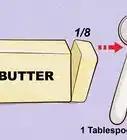This article was co-authored by Jennifer Levasseur. Chef Jennifer Levasseur is a Personal Chef and the Owner of The Happy Cuisiniere based in Breckenridge, Colorado. She has over 12 years of culinary experience and specializes in Mountain and Contemporary Rustic cuisine. Moreover, she can craft dishes and modify menus to accommodate dietary restrictions, such as gluten-free, vegetarian, vegan, pescatarian, and dairy-free diets. In addition to a Bachelor’s degree in Marketing and Management from the University of Houston, Chef Jennifer holds Associate’s degrees in Culinary Arts and Baking & Pastry Arts from Houston Community College.
wikiHow marks an article as reader-approved once it receives enough positive feedback. In this case, 100% of readers who voted found the article helpful, earning it our reader-approved status.
This article has been viewed 226,403 times.
Butterflying shrimp before grilling or frying it helps them cook more evenly and offers a pretty presentation. Shrimp are commonly butterflied by opening the flesh along the backs. It is also possible to butterfly shrimp along the inside belly, a process that's more time intensive but yields a unique result. See Step 1 to learn both ways to butterfly shrimp.
Steps
Preparing the Shrimp
-
1Wash the shrimp. Rinse all of your shrimp to remove any sand or other debris before you start the butterflying process. Store the shrimp you haven't yet butterflied in a bowl of ice to keep them fresh.
-
2Peel the shrimp. While you can cook shrimp that hasn't yet been peeled, butterflied shrimp is usually peeled before cooking. Peeling the shrimp opens up the flesh, making it easier to slice into it and create a butterflied shape. The tail may either be left in place or removed, depending on how you want your shrimp to look. To peel your shrimp:
- Pull off the heads (if your shrimp came with heads attached).
- Pull off the legs.
- Peel off the shells - slip your fingers under near the head, then peel it off the body.
- Leave the tails on or remove them.
Advertisement -
3Remove the digestive tract. This is the black, grey, or brown vein running along the shrimp's back. Before you can butterfly the shrimp, it needs to be removed. Position a paring knife at the head part of the shrimp, and gently slice along the shrimp's back to expose the digestive tract. Lift it out of the shrimp and wipe it off on a paper towel.
- If the tract breaks up into pieces, run the shrimp under a stream of water for a few seconds to wash it out.
- You can also use a shrimp deveiner to remove the digestive tract from smaller shrimp.
-
4Remove the nerve cord. Turn the shrimp over to check if it has a visible nerve cord, which runs along the inside curve. If you see a dark line there, you might want to remove it. The nerve cord is edible, but it can affect the appearance of the dish. To remove it, gently run the paring knife along the nerve cord to cut through the flesh and expose it. Lift the nerve cord from the shrimp and discard it.
- You can skip this step if you're battering and frying the shrimp, or if you don't mind the nerve cord being visible.
- Removing the nerve cord is a little trickier than removing the digestive tract. Be careful not to slice the shrimp all the way through.
Inside Butterfly
-
1Slice along the inside curve. Hold a paring knife so your index finger and thumb pinch the blade at the base of the handle. Take the knife and make a deeper cut along the inner curve of the shrimp so that the body is divided into two attached halves. Take care not to slice all the way through the shrimp.
-
2Rinse the shrimp and keep it cold. Place it under running water, then set in a bowl of ice to keep fresh while you finish butterflying the remaining shrimp.
Back Butterfly
-
1Use a knife to slice along the back curve.[1] If you already removed the digestive tract, you simply need to make the cut you've already made deeper. Place the tip of your knife in the cut near the head of the shrimp, then cut along the back all the way to the tail. Don't cut all the way through the shrimp - just deep enough so that the body divides into two connected halves, like a butterfly.
-
2Rinse the shrimp and keep it cold. Give it a quick rinse under cool tap water, then place it on ice to keep it cold while you butterfly the rest of the shrimp.
Community Q&A
-
QuestionCan I add cream to garlic fried shrimp and serve it over rice?
 KateKatey GirlCommunity AnswerYes you can! Add just a little bit, stir well, and taste. The cream should incorporate well with the butter/drippings from the garlic sauce.
KateKatey GirlCommunity AnswerYes you can! Add just a little bit, stir well, and taste. The cream should incorporate well with the butter/drippings from the garlic sauce. -
QuestionWhat do I need for dipping ingredients?
 Community AnswerCocktail sauce! To make it, mix 1 cup of ketchup, 1-2 tbsp horseradish to taste, 1 tbsp lemon juice, 1/2 tsp Worcestershire sauce, 1/4 tsp salt and a dash of pepper. Then let it chill in the fridge.
Community AnswerCocktail sauce! To make it, mix 1 cup of ketchup, 1-2 tbsp horseradish to taste, 1 tbsp lemon juice, 1/2 tsp Worcestershire sauce, 1/4 tsp salt and a dash of pepper. Then let it chill in the fridge.
wikiHow Video: How to Butterfly Shrimp
Warnings
- Use care when using the paring knife. If you're nervous about cutting yourself, where cut gloves that protect you from the blade.⧼thumbs_response⧽
Things You'll Need
- Strainer to rinse and drain shrimp
- Paring knife
- Cutting board
About This Article
To butterfly shrimp, start by washing and peeling the shrimps. Then, remove the digestive tract by cutting along the shrimp's back and lifting out the dark vein. Next, carefully slice along the inner curve of the shrimp so the body is divided in half, but not completely separated. Afterwards, rinse the shrimp under cool running water and place it in a bowl of ice while you butterfly the rest of your shrimps. For tips on how to back butterfly your shrimps, keep reading!

















































